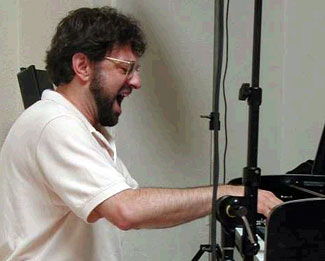|
There's a fundamental difference for documentarians between exploring the past and organizing the present.
The historian who mines the past is a detective, searching for ways to expand the scope and the cohesion of information that has been dwindling.
 Clues abound, but they aren't growing. With each year, the potential for errors magnifies, and the uninspected moments recede into quiet solitude. The chronicler who gives order to the present, however, has to make sense of more information than he could sift through in a lifetime. The present is everywhere, is ever changing, and so the historian has to pick and choose, define general movements and trends. Sometimes, though, a historian comes along and wants to catalog everything, to leave no stone unturned. More power to him, the rest of us think. Let him be our Sisyphus.
Clues abound, but they aren't growing. With each year, the potential for errors magnifies, and the uninspected moments recede into quiet solitude. The chronicler who gives order to the present, however, has to make sense of more information than he could sift through in a lifetime. The present is everywhere, is ever changing, and so the historian has to pick and choose, define general movements and trends. Sometimes, though, a historian comes along and wants to catalog everything, to leave no stone unturned. More power to him, the rest of us think. Let him be our Sisyphus.
For much of his career as a jazz historian (as well as a jazz pianist), Lewis Porter, the director of the Masters Program in Jazz History and Research at Rutgers University, has focused on the past. In one of his better known works, John Coltrane: His Life and Music, Porter investigated a life already much written about. But he took on the subject by starting at the beginning and taking nothing for granted. One example is the discrepancy he noticed between Coltrane's previously reported years of military service (December, 1945 - June, 1946) and the actual way in which military service generally plays out. How could he have started in the Navy band, as was previously reported, when he first started in the Navy? What about basic training? As it turns out, the date most biographers had used came from an interview where Coltrane said he was in the band from December, 1945 to June, 1946, not that he was in the military from December, 1945 to June, 1946.Military service records are publicly available, so Porter checked on it. Sure enough, the earlier figure was wrong, and Coltrane actually served from July, 1945 to August, 1946.
So what, right? We care about Coltrane the musician, not Coltrane the short-term soldier. But Porter insists, and makes a very convincing case, that this is exactly what is important. First, it gives fluidity and cohesion to a musician's life. Musicians are people, after all, with birthdays, anniversaries, family and sometimes also military service. Porter explains that "one thing that's missing in all the other reference works and a lot of what's written about jazz is any sense that jazz musicians have families. Look at a biography of anyone who's not a jazz musician: the first thing they go into is the family history. Whether you're looking at Edward R. Murrow, or any book about any president, or about James Joyce or Ernest Hemingway, the first thing they do is say his father was named this, his mother was named that and this is where he came from. So you have a sense that they didn't just land on this planet - Miles Davis didn't just land on the planet in 1926."
The second reason that comprehensive (and accurate) information is important is a little less direct, but is just as compelling. Jazz has always been an also-ran for historians, and even, more specifically, for musicologists. The discourse on Bach is very different from the discourse on John Coltrane. Keeping the history, then, becomes a struggle for the validity of jazz and its musicians. Huge institutional strides have been made of late, but we still look at its past with the kind of wonder that we usually save for mythology, or for things we don't know much about. Louis Armstrong and Charlie Parker are colossal figures who could pick up rail cars with their bare hands and bend street signs with their minds.
For Porter, jazz musicians are real people living in real places, and that they are part of a community of musicians that they both affect and are affected by. This has brought him headlong out of the past and into the present. He is presently working on
a jazz encyclopedia, but it won't be like the ones that came before it. Porter is aiming to include all living jazz musicians in his encyclopedia. Yes, all of them.
"It's great to have the Grove [New Grove Dictionary of Jazz] and the one that Leonard Feather did that was revised by Ira Gitler [The Biographical Encyclopedia of Jazz]," he said, "but they do a lot of picking and choosing of who quote-unquote 'deserves' to be in an encyclopedia. What I'd like to see out there is not to have anybody deciding whether you deserve to be in there or not, just a place to find anybody that you may hear on a recording or go see out in the club... The only bottom line is they have to be performing on a professional level."
Though don't take that to mean that a musician has to earn all of his money playing jazz, just that he plays actual gigs. Sisyphus, indeed, is in the building. ("Oh, no question about that," Portet said. "This rock is going to roll right over me.")
As biographical information goes, the encyclopedia is going to have everything. It'll have information on the musicians' parents, siblings, spouses and children; on radio, film and TV broadcasts and appearances; on unissued recordings; newspaper and magazine articles; awards; websites; contact information, and photos. There will be indexes based on last name, birth year and instrument. And, "because I'm a jazz historian, I have files on probably about 5,000 jazz musicians, of things that are in the news, things that I've observed myself and things that they've told me." Those will find their way into the book, as well.
There are a couple caveats (that the mam moth task requires superhuman patience is merely an aside). "The day it comes out, two things are going to happen," Porter said. "One is I'm going to have dozens of emails from musicians saying 'Oh, I changed my website or my phone number,' or 'I forgot to tell you something.' And the other thing that's going to happen is there'll be a whole new group. I'm sure there are going to be dozens of musicians a day saying, 'I didn't know about this - how did I not know about this? How come I'm not in there?'" But of course, he added, "that'll be the impetus for a new edition."
Another issue that will come up is that some musicians will pass away during the process of putting the book together. "I'm being a little bit flexible about that, because some cats have passed away in the last year or so. In some cases I'm in touch with the family. For instance, I know the widow of Ken McIntyre, and she says, 'you know I can give you a biography; I'm his widow; I know stuff that nobody knows.' And he just passed away, so why not?"
Porter understands that, for the encyclopedia to be a valuable reference tool, it must develop a context for the musicians. And so he aims to capture the essence of the jazz scene at this particular point in time. But he won't be writing articles on the music, like those that appear in the New Grove Dictionary of Jazz. What he will be doing to foster this context is letting the musicians write their own entries, which he says about a third of them have done so far (with Porter acting as fact-checker). Porter hopes that by encouraging musicians to write their own entries, they'll be able to share their stories as they see them, and in so doing, will create a collection of accurate representations of what's actually going on in jazz.
There are, of course, drawbacks to this system. Porter had initially intended to collect all of the information by January 1 of thi s year, but that hasn't happened yet. He's not drastically off-schedule, but he is certainly knee-deep in a lot more information than he expected. "It's been hours a day, getting my email, sorting it into files, making an index of who's responded so far," he said.
And the entries keep coming in. Porter said he's been surprised by the number of international submissions he's received from musicians he hadn't heard of, but who are very well-known in their home countries. They've been rolling in from the Netherlands, from Poland, from Finland. He's also been surprised by some of the big names who have personally sent him submissions, players such as Joe McPhee, Jane Ira Bloom and Roy Campbell. Initially, he thought he'd be doing most of the work for the musicians he knows of. ("Wynton Marsalis and Joshua Redman won't be sending me submissions.") So it's hard to step away from it all, although he knows he'll eventually have to. "There's going to be a point where I just have to call it quits. I'll just have to say, 'Okay, that's how big the book's going to be,' because it certainly could go on forever."
Until then, the pile of submissions grows, and the unturned stones are becoming harder to spot. It seems Dr. Porter might almost be getting this rock to the top of the hill. He comes back to explaining the value of contact information for the musicians, which Leonard Feather's encyclopedia had included, as well. Porter laughs and then says, "It's kind of fun, actually. You browse through it and it'll say 'Thelonius Monk,' and it'll have his address at West 64 Street." Time has a funny way of making history.
Lewis Porter is accepting entries for his jazz encyclopedia through May 15, 2003. He can be contacted at lrpjazz@aol.com
|



